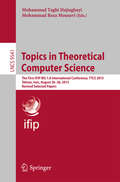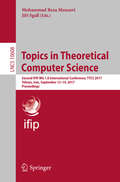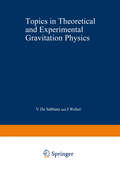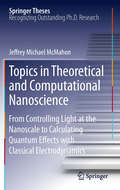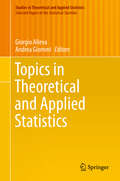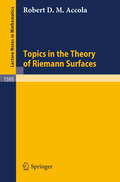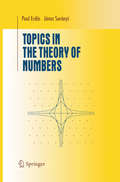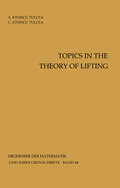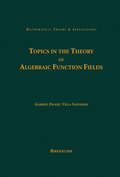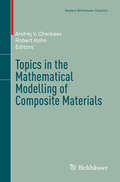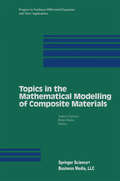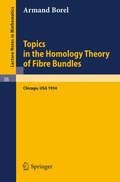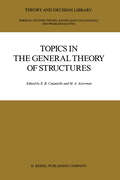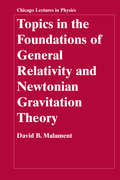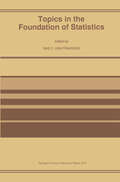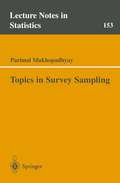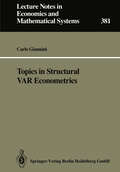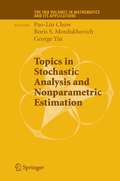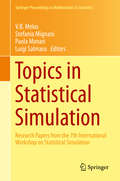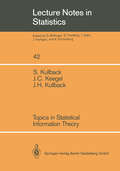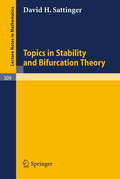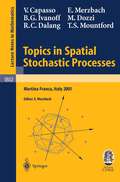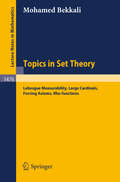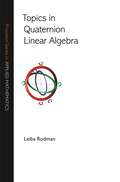- Table View
- List View
Topics in Theoretical Computer Science: The First IFIP WG 1.8 International Conference, TTCS 2015, Tehran, Iran, August 26-28, 2015, Revised Selected Papers (Lecture Notes in Computer Science #9541)
by Mohammad Taghi Hajiaghayi Mohammad Reza MousaviThis book constitutes the thoroughly refereed post-conference proceedings of the First IFIP WG 1.8 International Conference on Topics in Theoretical Computer Science, held in Tehran, Iran, in August 2015. The 10 full papers presented together with 3 invited talks were carefully reviewed and selected from 48 submissions. The papers feature novel and high-quality research in all areas of theoretical computer science.
Topics in Theoretical Computer Science: Second IFIP WG 1.8 International Conference, TTCS 2017, Tehran, Iran, September 12-14, 2017, Proceedings (Lecture Notes in Computer Science #10608)
by Mohammad Reza Mousavi Jiří SgallThis book constitutes the refereed proceedings of the Second IFIP WG 1.8 International Conference on Topics in Theoretical Computer Science, TTCS 2017, held in Tehran, Iran, in September 2017. The 8 papers presented in this volume were carefully reviewed and selected from 20 submissions. They were organized in topical sections named: algorithms and complexity; and logic, semantics, and programming theory.
Topics in Theoretical and Experimental Gravitation Physics (NATO Science Series B: #27)
by V. De SabbataTopics in Theoretical and Computational Nanoscience: From Controlling Light at the Nanoscale to Calculating Quantum Effects with Classical Electrodynamics (Springer Theses)
by Jeffrey Michael McMahonInterest in structures with nanometer-length features has significantly increased as experimental techniques for their fabrication have become possible. The study of phenomena in this area is termed nanoscience, and is a research focus of chemists, pure and applied physics, electrical engineers, and others. The reason for such a focus is the wide range of novel effects that exist at this scale, both of fundamental and practical interest, which often arise from the interaction between metallic nanostructures and light, and range from large electromagnetic field enhancements to extraordinary optical transmission of light through arrays of subwavelength holes.This dissertation is aimed at addressing some of the most fundamental and outstanding questions in nanoscience from a theoretical and computational perspective, specifically: · At the single nanoparticle level, how well do experimental and classical electrodynamics agree?· What is the detailed relationship between optical response and nanoparticle morphology, composition, and environment?· Does an optimal nanostructure exist for generating large electromagnetic field enhancements, and is there a fundamental limit to this? · Can nanostructures be used to control light, such as confining it, or causing fundamentally different scattering phenomena to interact, such as electromagnetic surface modes and diffraction effects?· Is it possible to calculate quantum effects using classical electrodynamics, and if so, how do they affect optical properties?
Topics in Theoretical and Applied Statistics (Studies in Theoretical and Applied Statistics #0)
by Giorgio Alleva Andrea GiommiThis book highlights the latest research findings from the 46th International Meeting of the Italian Statistical Society (SIS) in Rome, during which both methodological and applied statistical research was discussed. This selection of fully peer-reviewed papers, originally presented at the meeting, addresses a broad range of topics, including the theory of statistical inference; data mining and multivariate statistical analysis; survey methodologies; analysis of social, demographic and health data; and economic statistics and econometrics.
Topics in the Theory of Riemann Surfaces (Lecture Notes in Mathematics #1595)
by Robert D.M. AccolaThe book's main concern is automorphisms of Riemann surfaces, giving a foundational treatment from the point of view of Galois coverings, and treating the problem of the largest automorphism group for a Riemann surface of a given genus. In addition, the extent to which fixed points of automorphisms are generalized Weierstrass points is considered. The extremely useful inequality of Castelnuovo- Severi is also treated. While the methods are elementary, much of the material does not appear in the current texts on Riemann surfaces, algebraic curves. The book is accessible to a reader who has had an introductory course on the theory of Riemann surfaces or algebraic curves.
Topics in the Theory of Numbers (Undergraduate Texts in Mathematics)
by Janos Suranyi Paul ErdösNumber theory, the branch of mathematics that studies the properties of the integers, is a repository of interesting and quite varied problems, sometimes impossibly difficult ones. In this book, the authors have gathered together a collection of problems from various topics in number theory that they find beautiful, intriguing, and from a certain point of view instructive.
Topics in the Theory of Lifting (Ergebnisse der Mathematik und ihrer Grenzgebiete. 2. Folge #48)
by Alexandra Ionescu Tulcea C. Ionescu TulceaThe problem as to whether or not there exists a lifting of the M't/. 1 space ) corresponding to the real line and Lebesgue measure on it was first raised by A. Haar. It was solved in a paper published in 1931 [102] by 1. von Neumann, who established the existence of a lifting in this case. In subsequent papers J. von Neumann and M. H. Stone [105], and later on 1. Dieudonne [22], discussed various algebraic aspects and generalizations of the problem. Attemps to solve the problem as to whether or not there exists a lifting for an arbitrary M't/. space were unsuccessful for a long time, although the problem had significant connections with other branches of mathematics. Finally, in a paper published in 1958 [88], D. Maharam established, by a delicate argument, that a lifting of M't/. always exists (for an arbi trary space of a-finite mass). D. Maharam proved first the existence of a lifting of the M't/. space corresponding to a product X = TI {ai,b,} ieI and a product measure J.1= Q9 J.1i' with J.1i{a;}=J.1i{b,}=! for all iE/. ,eI Then, she reduced the general case to this one, via an isomorphism theorem concerning homogeneous measure algebras [87], [88]. A different and more direct proof of the existence of a lifting was subsequently given by the authors in [65]' A variant of this proof is presented in chapter 4.
Topics in the Theory of Algebraic Function Fields (Mathematics: Theory & Applications)
by Gabriel Daniel Villa SalvadorThe fields of algebraic functions of one variable appear in several areas of mathematics: complex analysis, algebraic geometry, and number theory. This text adopts the latter perspective by applying an arithmetic-algebraic viewpoint to the study of function fields as part of the algebraic theory of numbers. The examination explains both the similarities and fundamental differences between function fields and number fields, including many exercises and examples to enhance understanding and motivate further study. The only prerequisites are a basic knowledge of field theory, complex analysis, and some commutative algebra.
Topics in the Mathematical Modelling of Composite Materials (Modern Birkhäuser Classics)
by Andrej V. Cherkaev Robert KohnOver the past several decades, we have witnessed a renaissance of theoretical work on the macroscopic behavior of microscopically heterogeneous materials. This activity brings together a number of related themes, including: (1) the use of weak convergence as a rigorous yet general language for the discussion of macroscopic behavior; (2) interest in new types of questions, particularly the "G-closure problem," motivated in large part by applications of optimal control theory to structural optimization; (3) the introduction of new methods for bounding effective moduli, including one based on "compensated compactness"; and (4) the identification of deep links between the analysis of microstructures and the multidimensional calculus of variations. This work has implications for many physical problems involving optimal design, composite materials, and coherent phase transitions. As a result, it has received attention and support from numerous scientific communities, including engineering, materials science, and physics, as well as mathematics. There is by now an extensive literature in this area. But for various reasons certain fundamental papers were never properly published, circulating instead as mimeographed notes or preprints. Other work appeared in poorly distributed conference proceedings volumes. Still other work was published in standard books or journals, but written in Russian or French. The net effect is a sort of "gap" in the literature, which has made the subject unnecessarily difficult for newcomers to penetrate. The present, softcover reprint is designed to make this classic text available to a wider audience. "Summarizes some of the fundamental results achieved and offers new perspectives in the mechanics of composite and micromechanics... Will become a classic in the two fields." —Applied Mechanics Review
Topics in the Mathematical Modelling of Composite Materials (Progress in Nonlinear Differential Equations and Their Applications #31)
by Andrej V. Cherkaev Robert KohnAndrej V. Cherkaev and Robert V. Kohn In the past twenty years we have witnessed a renaissance of theoretical work on the macroscopic behavior of microscopically heterogeneous mate rials. This activity brings together a number of related themes, including: ( 1) the use of weak convergence as a rigorous yet general language for the discussion of macroscopic behavior; (2) interest in new types of questions, particularly the "G-closure problem," motivated in large part by applications of optimal control theory to structural optimization; (3) the introduction of new methods for bounding effective moduli, including one based on "com pensated compactness"; and (4) the identification of deep links between the analysis of microstructures and the multidimensional calculus of variations. This work has implications for many physical problems involving optimal design, composite materials, and coherent phase transitions. As a result it has received attention and support from numerous scientific communities, including engineering, materials science, and physics as well as mathematics. There is by now an extensive literature in this area. But for various reasons certain fundamental papers were never properly published, circu lating instead as mimeographed notes or preprints. Other work appeared in poorly distributed conference proceedings volumes. Still other work was published in standard books or journals, but written in Russian or French. The net effect is a sort of "gap" in the literature, which has made the subject unnecessarily difficult for newcomers to penetrate.
Topics in the Homology Theory of Fibre Bundles: Lectures Given at the University of Chicago, 1954 (Lecture Notes in Mathematics #36)
by Armand BorelTopics in the General Theory of Structures (Theory and Decision Library D: #1)
by E. R. Caianiello M. A. AizermanThis volume is about "Structure". The search for "structure", always the pursuit of sciences within their specific areas and perspectives, is witnessing these days a dra matic revolution. The coexistence and interaction of so many structures (atoms, hu mans, cosmos and all that there is in between) would be unconceivable according to many experts, if there were not, behind it all, some gen eral organizational principle. s that (at least in some asymptotic way) make possible so many equilibria among species and natural objects, fan tastically tuned to an extremely high degree of precision. The evidence accumulates to an increasingly impressive degree; a concrete example comes from physics, whose constant aim always was and is that of searching for "ultimate laws", out of which everything should follow, from quarks to the cosmos. Our notions and philosophy have un dergone major revolutions, whenever the "unthinkable" has been changed by its wonderful endeavours into "fact". Well, it is just from physics that evidence comes: even if the "ultimate" could be reached, it would not in any way be a terminal point. When "complexity" comes into the game, entirely new notions have to be invented; they all have to do with "structure", though this time in a much wider sense than would have been understood a decade or so ago.
Topics in the Foundations of General Relativity and Newtonian Gravitation Theory (Chicago Lectures in Physics)
by David B. MalamentIn Topics in the Foundations of General Relativity and Newtonian Gravitation Theory, David B. Malament presents the basic logical-mathematical structure of general relativity and considers a number of special topics concerning the foundations of general relativity and its relation to Newtonian gravitation theory. These special topics include the geometrized formulation of Newtonian theory (also known as Newton-Cartan theory), the concept of rotation in general relativity, and Gödel spacetime. One of the highlights of the book is a no-go theorem that can be understood to show that there is no criterion of orbital rotation in general relativity that fully answers to our classical intuitions. Topics is intended for both students and researchers in mathematical physics and philosophy of science.
Topics in the Foundations of General Relativity and Newtonian Gravitation Theory (Chicago Lectures in Physics)
by David B. MalamentIn Topics in the Foundations of General Relativity and Newtonian Gravitation Theory, David B. Malament presents the basic logical-mathematical structure of general relativity and considers a number of special topics concerning the foundations of general relativity and its relation to Newtonian gravitation theory. These special topics include the geometrized formulation of Newtonian theory (also known as Newton-Cartan theory), the concept of rotation in general relativity, and Gödel spacetime. One of the highlights of the book is a no-go theorem that can be understood to show that there is no criterion of orbital rotation in general relativity that fully answers to our classical intuitions. Topics is intended for both students and researchers in mathematical physics and philosophy of science.
Topics in the Foundation of Statistics
by B. C. Van FraassenFoundational research focuses on the theory, but theories are to be related also to other theories, experiments, facts in their domains, data, and to their uses in applications, whether of prediction, control, or explanation. A theory is to be identified through its class of models, but not so narrowly as to disallow these roles. The language of science is to be studied separately, with special reference to the relations listed above, and to the consequent need for resources other than for theoretical description. Peculiar to the foundational level are questions of completeness (specifically in the representation of measurement), and of interpretation (a topic beset with confusions of truth and evidence, and with inappropriate metalinguistic abstraction).
Topics in Survey Sampling (Lecture Notes in Statistics #153)
by Parimal MukhopadhyayThe aim of this book is to make a comprehensive review on some of the research topics in the area of survey sampling which has not been covered in any book yet. The proposed book aims at making a comprehensive review of applications of Bayes procedures, Empirical Bayes procedures and their ramifications (like linear Bayes estimation, restricted Bayes least square prediction, constrained Bayes estimation, Bayesian robustness) in making inference from a finite population sampling. Parimal Mukhopadhyay is Professor at the Indian Statistical Institute (ISI), Calcutta. He received his Ph.D. degree in Statistics from the University of Calcutta in 1977. He also served as a faculty member in the University of Ife, Nigeria, Moi University, Kenya, University of South Pacific, Fiji Islands and held visiting positions at University of Montreal, University of Windsor, Stockholm University, University of Western Australia, etc. He has to his credit more than fifty research papers in Survey Sampling, some co-authored, three text books on Statistics and three research monographs in Survey Sampling. He is a member of the Institute of Mathematical Statistics and an elected member of the International Statistical Institute.
Topics in Structural VAR Econometrics (Lecture Notes in Economics and Mathematical Systems #381)
by Carlo Giannini1. Introduction 1 2. Identification Analysis and F.I.M.L. Estimation for the K-Mode1 10 3. Identification Analysis and F.I.ML. Estimation for the C-Model 23 4. Identification Analysis and F.I.M.L. Estimation for the AB-Model 32 5. Impulse Response Analysis and Forecast Error Variance Decomposition in SVAR Modeling 44 5 .a Impulse Response Analysis 44 5.b Variance Decomposition (by Antonio Lanzarotti) 51 6. Long-run A-priori Information. Deterministic Components. Cointegration 58 6.a Long-run A-priori Information 58 6.b Deterministic Components 62 6.c Cointegration 65 7. The Working of an AB-Model 71 Annex 1: The Notions ofReduced Form and Structure in Structural VAR Modeling 83 Annex 2: Some Considerations on the Semantics, Choice and Management of the K, C and AB-Models 87 Appendix A 93 Appendix B 96 Appendix C (by Antonio Lanzarotti and Mario Seghelini) 99 Appendix D (by Antonio Lanzarotti and Mario Seghelini) 109 References 128 Foreword In recent years a growing interest in the structural VAR approach (SVAR) has followed the path-breaking works by Blanchard and Watson (1986), Bemanke (1986) and Sims (1986), especially in U.S. applied macroeconometric literature. The approach can be used in two different, partially overlapping directions: the interpretation ofbusiness cycle fluctuations of a small number of significantmacroeconomic variables and the identification of the effects of different policies.
Topics in Stochastic Analysis and Nonparametric Estimation (The IMA Volumes in Mathematics and its Applications #145)
by Pao-Liu Chow Boris S. Mordukhovich G. George YinTo honor Rafail Z. Khasminskii, on his seventy-fifth birthday, for his contributions to stochastic processes and nonparametric estimation theory an IMA participating institution conference entitled "Conference on Asymptotic Analysis in Stochastic Processes, Nonparametric Estimation, and Related Problems" was held. This volume commemorates this special event. Dedicated to Professor Khasminskii, it consists of nine papers on various topics in probability and statistics.
Topics in Statistical Simulation: Research Papers from the 7th International Workshop on Statistical Simulation (Springer Proceedings in Mathematics & Statistics #114)
by V. B. Melas Stefania Mignani Paola Monari Luigi SalmasoThe Department of Statistical Sciences of the University of Bologna in collaboration with the Department of Management and Engineering of the University of Padova, the Department of Statistical Modelling of Saint Petersburg State University, and INFORMS Simulation Society sponsored the Seventh Workshop on Simulation. This international conference was devoted to statistical techniques in stochastic simulation, data collection, analysis of scientific experiments, and studies representing broad areas of interest. The previous workshops took place in St. Petersburg, Russia in 1994, 1996, 1998, 2001, 2005, and 2009. The Seventh Workshop took place in the Rimini Campus of the University of Bologna, which is in Rimini’s historical center.
Topics in Statistical Information Theory (Lecture Notes in Statistics #42)
by Solomon Kullback John C. Keegel Joseph H. KullbackThe relevance of information theory to statistical theory and its applications to stochastic processes is a unifying influence in these TOPICS. The integral representation of discrimination information is presented in these TOPICS reviewing various approaches used in the literature, and is also developed herein using intrinsically information-theoretic methods. Log likelihood ratios associated with various stochastic processes are computed by an application of minimum discrimination information estimates. Linear discriminant functionals are used in the information-theoretic analysis of a variety of stochastic processes. Sections are numbered serially within each chapter, with a decimal notation for subsections. Equations, examples, theorems and lemmas, are numbered serially within each section with a decimal notation. The digits to the left of the decimal point represent the section and the digits to the right of the decimal point the serial number within the section. When reference is made to a section, equation, example, theorem or lemma within the same chapter only the section number or equation number, etc., is given. When the reference is to a section ,equation, etc., in a different chapter, then in addition to the section or equation etc., number, the chapter number is also given. References to the bibliography are by the author's name followed by the year of publication in parentheses. The transpose of a matrix is denoted by a prime; thus one-row matrices are denoted by primes as the transposes of one-column matrices (vectors).
Topics in Stability and Bifurcation Theory (Lecture Notes in Mathematics #309)
by David H. SattingerTopics in Spatial Stochastic Processes: Lectures given at the C.I.M.E. Summer School held in Martina Franca, Italy, July 1-8, 2001 (Lecture Notes in Mathematics #1802)
by Vincenzo Capasso Ely Merzbach B. Gail Ivanoff Marco Dozzi Robert Dalang Thomas MountfordThe theory of stochastic processes indexed by a partially ordered set has been the subject of much research over the past twenty years. The objective of this CIME International Summer School was to bring to a large audience of young probabilists the general theory of spatial processes, including the theory of set-indexed martingales and to present the different branches of applications of this theory, including stochastic geometry, spatial statistics, empirical processes, spatial estimators and survival analysis. This theory has a broad variety of applications in environmental sciences, social sciences, structure of material and image analysis. In this volume, the reader will find different approaches which foster the development of tools to modelling the spatial aspects of stochastic problems.
Topics in Set Theory: Lebesgue Measurability, Large Cardinals, Forcing Axioms, Rho-functions (Lecture Notes in Mathematics #1476)
by Mohamed BekkaliDuring the Fall Semester of 1987, Stevo Todorcevic gave a series of lectures at the University of Colorado. These notes of the course, taken by the author, give a novel and fast exposition of four chapters of Set Theory. The first two chapters are about the connection between large cardinals and Lebesque measure. The third is on forcing axioms such as Martin's axiom or the Proper Forcing Axiom. The fourth chapter looks at the method of minimal walks and p-functions and their applications. The book is addressed to researchers and graduate students interested in Set Theory, Set-Theoretic Topology and Measure Theory.
Topics in Quaternion Linear Algebra
by Leiba RodmanQuaternions are a number system that has become increasingly useful for representing the rotations of objects in three-dimensional space and has important applications in theoretical and applied mathematics, physics, computer science, and engineering. This is the first book to provide a systematic, accessible, and self-contained exposition of quaternion linear algebra. It features previously unpublished research results with complete proofs and many open problems at various levels, as well as more than 200 exercises to facilitate use by students and instructors. Applications presented in the book include numerical ranges, invariant semidefinite subspaces, differential equations with symmetries, and matrix equations.Designed for researchers and students across a variety of disciplines, the book can be read by anyone with a background in linear algebra, rudimentary complex analysis, and some multivariable calculus. Instructors will find it useful as a complementary text for undergraduate linear algebra courses or as a basis for a graduate course in linear algebra. The open problems can serve as research projects for undergraduates, topics for graduate students, or problems to be tackled by professional research mathematicians. The book is also an invaluable reference tool for researchers in fields where techniques based on quaternion analysis are used.
